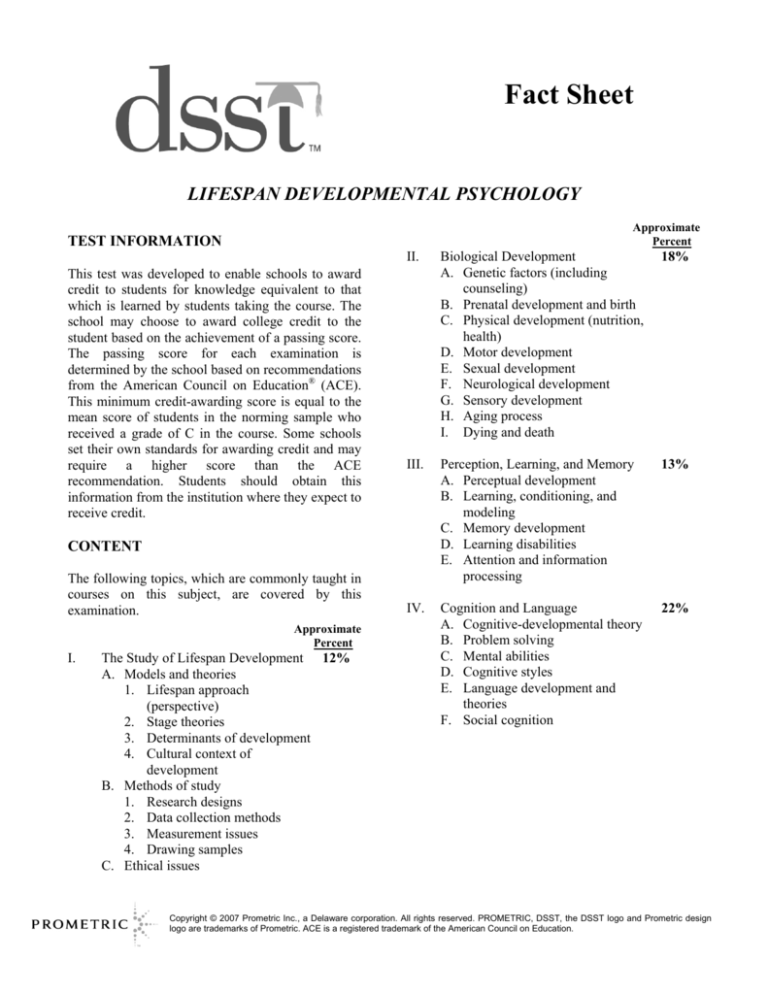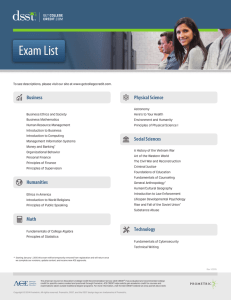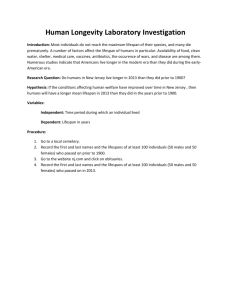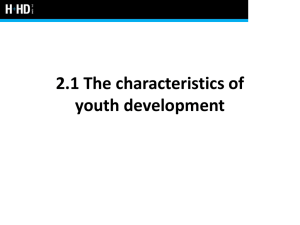
Fact Sheet
LIFESPAN DEVELOPMENTAL PSYCHOLOGY
Approximate
Percent
TEST INFORMATION
This test was developed to enable schools to award
credit to students for knowledge equivalent to that
which is learned by students taking the course. The
school may choose to award college credit to the
student based on the achievement of a passing score.
The passing score for each examination is
determined by the school based on recommendations
from the American Council on Education® (ACE).
This minimum credit-awarding score is equal to the
mean score of students in the norming sample who
received a grade of C in the course. Some schools
set their own standards for awarding credit and may
require a higher score than the ACE
recommendation. Students should obtain this
information from the institution where they expect to
receive credit.
II.
Biological Development
A. Genetic factors (including
counseling)
B. Prenatal development and birth
C. Physical development (nutrition,
health)
D. Motor development
E. Sexual development
F. Neurological development
G. Sensory development
H. Aging process
I. Dying and death
18%
III.
Perception, Learning, and Memory
A. Perceptual development
B. Learning, conditioning, and
modeling
C. Memory development
D. Learning disabilities
E. Attention and information
processing
13%
IV.
Cognition and Language
A. Cognitive-developmental theory
B. Problem solving
C. Mental abilities
D. Cognitive styles
E. Language development and
theories
F. Social cognition
22%
CONTENT
The following topics, which are commonly taught in
courses on this subject, are covered by this
examination.
Approximate
Percent
I.
The Study of Lifespan Development 12%
A. Models and theories
1. Lifespan approach
(perspective)
2. Stage theories
3. Determinants of development
4. Cultural context of
development
B. Methods of study
1. Research designs
2. Data collection methods
3. Measurement issues
4. Drawing samples
C. Ethical issues
Copyright © 2007 Prometric Inc., a Delaware corporation. All rights reserved. PROMETRIC, DSST, the DSST logo and Prometric design
logo are trademarks of Prometric. ACE is a registered trademark of the American Council on Education.
Approximate
Percent
V.
Social, Emotional, and Personality
Development
A. Personality development
1. Development tasks and
life-stage theories
2. Attachment and emotional
development
3. Gender role development
4. Stability and change in
personality
B. Social behaviors
1. Peer relationships
2. Aggressive behavior
3. Prosocial behavior
4. Moral development
5. Sexual attitudes and behavior
C. Family life cycle
1. Courtship and marriage
2. Parenting
3. Siblings
4. Grandparents
5. Dual-income families
6. Divorced, single-parent, and
step families
7. Widow/widowerhood
8. Abuse (child, spouse, elderly)
9. Intergenerational relationships
D. Extrafamilial settings
(e.g., day-care, school, nursing
home, hospice)
E. Singlehood and cohabitation
F. Occupational development and
retirement
G. Adjustment, life stresses, and
life-styles
H. Bereavement and loss
In addition, the test will cover the full range of
stages in the lifespan as follows:
5%
Understanding of concepts and principles
(about 30-35% of the examination)
•
Ability to apply knowledge to specific problems
and situations
(about 35-40% of the examination)
%
Prenatal and Infancy
Early childhood
Middle childhood
Adolescence
Early adulthood
Middle adulthood
Late adulthood
less than 2
2-6
7 - 12
13 - 18
19 - 40
41 - 64
65 and older
19%
19%
15%
15%
7%
11%
14%
1. According to Erik Erikson, the first stage of
psychosocial development deals primarily with
the development of
(A)
(B)
(C)
(D)
autonomy
industry
initiative
trust
2. Which of the following neonatal reflexes is most
closely related to feeding?
(A)
(B)
(C)
(D)
Babinski
Moro
Palmer
Rooting
3. Which of the following has NOT proposed a
stage theory of development?
(A)
(B)
(C)
(D)
B.F. Skinner
Jean Piaget
Lawrence Kohlberg
Sigmund Freud
4. A distinct advantage of a longitudinal research
design is that it
(A)
Knowledge of basic facts and terms
(about 25-30% of the examination)
•
Ages
SAMPLE QUESTIONS
Questions on the test require candidates to
demonstrate the following abilities. Some questions
require more than one of the abilities.
•
Stage
(B)
(C)
(D)
2
is economical for investigating behavioral
consistencies across situations
enables the researcher to study the
behavior of individuals over time
automatically controls for the selective
dropout of experimental subjects
allows the researcher to gather data on a
given cohort at one point in time
5. Which of the following theorists proposed that
early language development is primarily the
result of innate factors?
(A)
(B)
(C)
(D)
10. Which of the following is a correct
generalization regarding the adolescent growth
spurt?
B.F. Skinner
Albert Bandura
Jean Piaget
Noam Chomsky
(A)
(B)
(C)
(D)
6. Research suggests that sex differences in
behavior occur most consistently in which of the
following areas?
(A)
(B)
(C)
(D)
11. Anne and Richard are married and have three
children. Their older son lives in a distant locale,
their second son is in college, and their daughter
attends a local public high school. According to
Evelyn Duvall, which of the following terms
best characterizes Anne’s and Richard’s period
of parenthood?
Verbal comprehension
Aggression
Emotionality
Independence
7. All of the following statements regarding
intellectual decline in elderly persons are true
EXCEPT:
(A)
(B)
(C)
(D)
(A)
(B)
(C)
(D)
It occurs most often in mental activities
involving quick reactions.
It can occur in the absence of a detectable
disease.
It occurs primarily among individuals of
above-average intelligence.
The greatest decline tends to occur in the
years just preceding death.
(A)
(B)
(C)
(D)
It decreases for long-ago events.
It decreases for recent events.
It increases for long-ago events.
It increases for recent events.
STUDYING FOR THE EXAMINATION
The following is a list of reference publications that
were being used as textbooks in college courses of
the same or similar title at the time the test was
developed. Appropriate textbooks for study are not
limited to those listed below. If you wish to obtain
study resources to prepare for the examination, you
may reference either the current edition of the
following titles or textbooks currently used at a local
college or university for the same class title. It is
recommended that you reference more than one
textbook on the topics outlined in this fact sheet.
You should begin by checking textbook content
against the content outline included on the front
page of this Fact Sheet before selecting textbooks
that cover the test content from which to study.
Textbooks may be found at the campus bookstore of
a local college or university offering a course on the
subject.
Creation of an imaginary audience
Unwillingness to share with one’s peers
Cheating in highly competitive situations
Attention-getting behavior
9. Jennifer is known to be a Level 1 in Kohlberg’s
stages of moral reasoning. She is most likely to
believe that it is wrong to steal because the
person who steals
(A)
(B)
(C)
(D)
Launching
Authoritative
Nurturing
Empty nest
12. Which of the following best describes the impact
of aging on long-term memory?
8. According to David Elkind, egocentrism during
adolescence is most likely to be manifested in
which of the following ways?
(A)
(B)
(C)
(D)
It starts between the ages of 15 and 18
years.
It is unaffected by nutritional factors.
It is prolonged among first-born children.
It occurs earlier in girls than in boys.
gets punished
disobeys the law
lacks respect for others’ rights
is seen as unpopular by most people
3
Sources for study material suggested but not limited
to the following:
CREDIT RECOMMENDATIONS
The Center for Adult Learning and Educational
Credentials for the American Council on
Education (ACE) has reviewed and evaluated
the DSST examination development process.
The American Council on Education has made
the following recommendations:
Berger, Kathleen S. The Developing Person
Through the Life Span. New York, NY: Worth
Publishers, current edition.
Cole, Michael and Sheila Cole. The Development of
Children. New York, NY: W.H. Freeman, current
edition.
Area or Course
Equivalent:
Craig, Grace J. Human Development. Upper Saddle
River, NJ: Prentice Hall, current edition.
Dworetzky, J.P. and N.J. Davis. Human
Development: A Lifespan Approach. St. Paul, MN:
West Publishing Co., current edition.
Level:
Amount of Credit:
Source:
Gormly, Anne V. Lifespan Human Development.
Fort Worth, TX: Harcourt Brace College Publishers,
current edition.
INFORMATION
Hughes, Fergus P. and Ilene C. Noppe. Human
Development Across the Lifespan. New York, NY:
Merrill/Macmillan, current edition.
Lifespan Developmental
Psychology
Lower-level baccalaureate
Three (3) semester hours
ACE Commission on
Educational Credit and
Credentials
Colleges and universities that would like additional
information about the national norming, or
assistance in local norming or score validation
studies should write to: DSST Program, Prometric,
2000 Lenox Drive, 3rd Floor, Lawrenceville, NJ
08648.
Lefrancois, Guy R. The Lifespan. Belmont, CA:
Wadsworth Publishing Company, current edition.
Papalia, Diane E., Sally W. Olds and Ruth Duskin
Feldman. Human Development. New York, NY:
McGraw-Hill, current edition.
It is advisable that schools develop a consistent
policy about awarding credit based on scores from
this test and that the policy be reviewed periodically.
Prometric will be happy to help schools in this
effort.
Rice, F. Philip. Human Development: A Life-span
Approach. Upper Saddle River, NJ: Prentice Hall,
current edition.
Santrock, John W. Life-span Development. Boston,
MA: McGraw-Hill, current edition.
Sigelman, Carol K. and David R. Shaffer. Life-span
Human Development. Pacific Grove, CA:
Brooks/Cole Publishing Co., current edition.
Turner, Jeffrey, and Donald Helms. Lifespan
Development. Fort Worth, TX: Harcourt Brace
College Publishers, current edition.
Vander Zanden, James W. Human Development.
New York, NY: McGraw-Hill, current edition.
Current textbook used by a local college or
university for a course on the subject.
Rev. 20071116 - I.N. 390490
4







